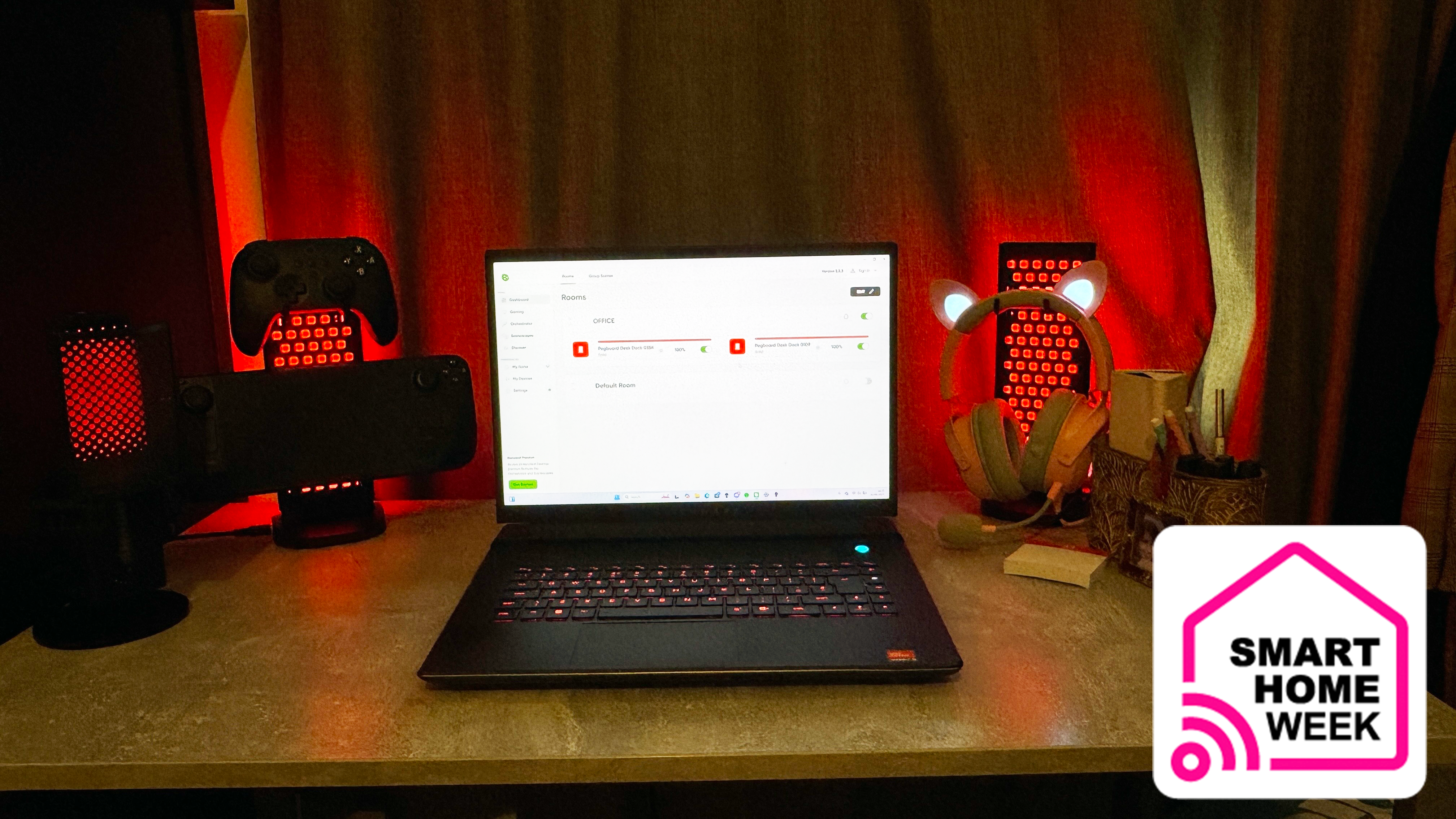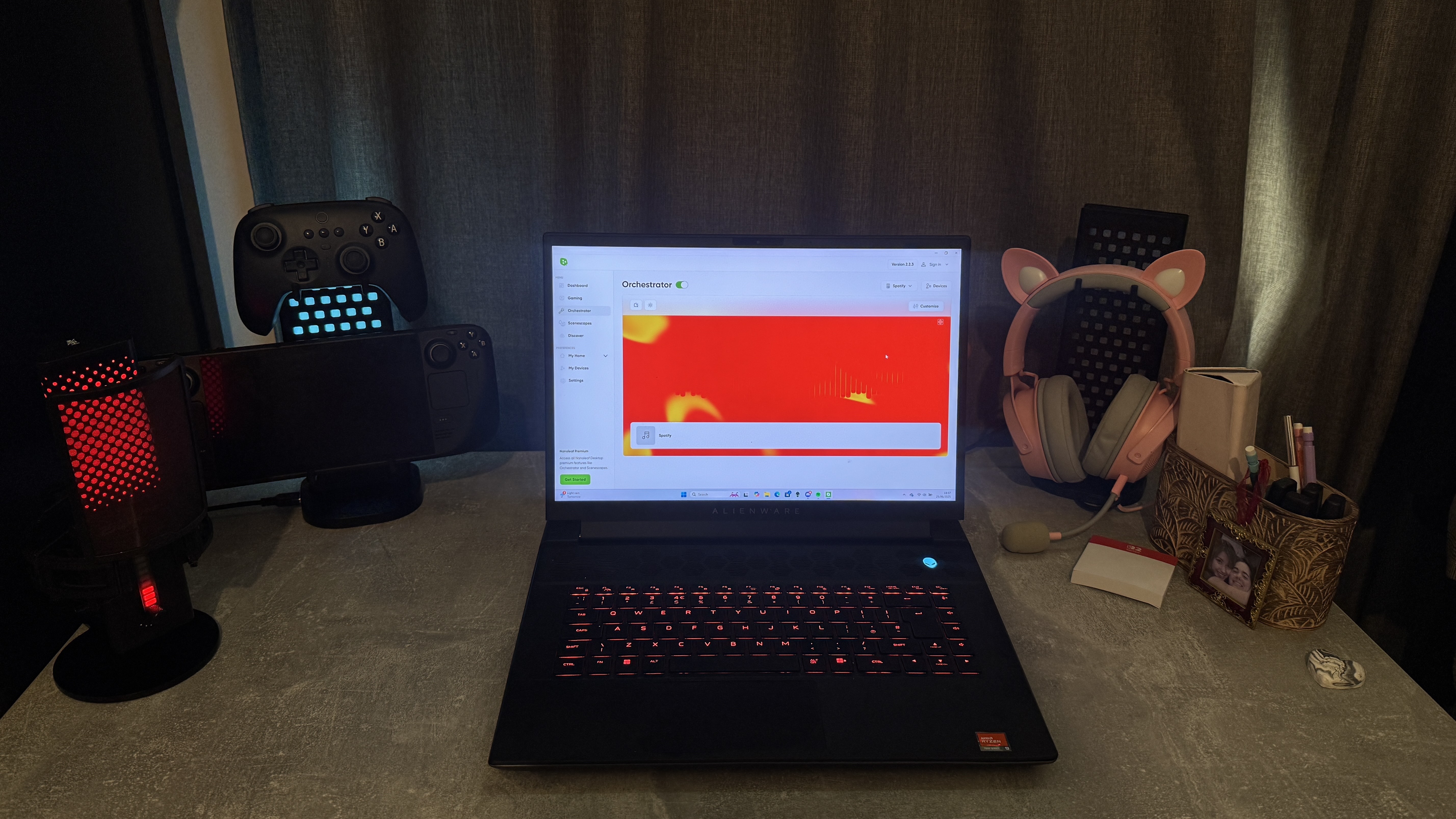I tried to make an immersive smart lighting gaming desk setup and failed horribly – here's why

I wouldn't call myself a flashy person, but when it comes to smart lighting, I'm prepared to go all-out. In my home, I'm using everything from standing lamps like Philips Hue's Signe gradient lamp and TV backlight to the Govee Table Lamp 2 to give my home lighting some pizzazz.
Until recently, my setup included my beloved Nanoleaf black hexagon wall panels, which served both as traditional and immersive smart lighting when hooked up to my PC via the Nanoleaf Desktop app, in addition to the remote controls afforded by the mobile app. Unfortunately, my new digs don't afford me the wallspace for these, so I was excited to see if Nanoleaf's latest gaming release, the Pegboard Desk Dock, would suitably fill the RGB-shaped void in my life.
Would that it were so simple.
I didn't peg you as a quitter
I'm in the throes of reviewing Nanoleaf's Pegboard Desk Dock, so this is far from a final verdict, but my early impressions tell a cautionary tale for all immersive lighting enthusiasts. This 3-in-1 smart light and desktop combo is an awesome concept; smartly designed, arriving with four hooks each, which can be arranged on the Pegboard to hold your gaming controllers, handheld PCs, and headsets. If you'd rather just have the Pegboard as a display piece, you can easily pull it out of the base and turn it around to show the rear light panel.
For me, this was a dream product. I'm always looking for ways to optimize my desk space, especially since I downsized when moving home, and I love Nanoleaf's wider range of smart lights.
So, after eagerly unboxing and setting up my new lights, I was eager to see my new setup in all its glory. Just watching the lights cycle through the colors of the rainbow before I'd even paired them with Nanoleaf's software was exciting enough.
Unlike many of Nanoleaf's other products, however, the Pegboard can't be added to the Nanoleaf mobile app; it works exclusively within the Nanoleaf Desktop app, and that's where my first problem came in.
Sign up for breaking news, reviews, opinion, top tech deals, and more.
While the lights' basic settings worked just fine when unpaired, as soon as I connected them to the app and tried to change their color output, they ceased to function, flashing on and off sporadically, rejecting any peripherals I plugged into the base and intermittently appearing as "Unreachable" within the Nanoleaf app.
I'd thought it was perhaps because they needed more power, so I plugged in my power supply; no joy. The software also offers little troubleshooting for the problem, and with everything running smoothly until the point I tried to pair them, I've come up short trying to fix them myself. I've yet to contact Nanoleaf about the issue, which I'll surely do before I give my final verdict, and I'm more than certain that a resolution exists; however, my experience paints a broader picture of immersive smart home lighting challenges.

Bigger fish to fry
I don't relish bemoaning the woeful state of smart home interoperability once again. The simple fact is, it's everyone's biggest problem, and that's not exclusive to smart lighting for the home; any smart home brand taking the walled garden approach, of which there are many, earns my ire in the age of Matter compatibility.
Gaming lights, in particular, suffer. On my gaming laptop, I've got a plethora of RGB and smart light controlling apps; Logitech G Hub, HyperX NGENUITY, Corsair iCUE, Razer Chroma, and Nanoleaf being the ones I used for this setup.
Now, some of these play nice with each other; namely, Nanoleaf links up to both Corsair iCUE and Razer Chroma, but that still leaves half of my peripherals setup disconnected. You're also at the mercy of software updates, which, especially if you use a hub app with multiple platforms connected to it, can make or break your setup.
There's also the non-small issue of the software itself. Running these background apps, especially if you aren't able to whittle them down by integrating different platforms, can use a fair bit of CPU and RAM. Especially if you're playing on a more lightweight machine, that can end up being pretty detrimental for high-stakes gaming.
Not all hope is lost when it comes to immersive smart lighting, though. Software like SignalRGB and OpenRGB goes a long way to mitigate compatibility problems, even if these are far from perfect. Still, things are heading in the right direction, just at a glacial pace – and if smart light makers want to light up the lives of gamers the world over, that will need to change to keep up with the sophisticated interfaces and experiences we're used to from our tech.
Even when it comes to immersive lighting for the TV, you can bet things are never simple. Screen extending lighting is increasingly popular, yet your options these days are limited; splurge on a pricey Philips Ambilight TV, opt for the still-pricey Hue light strip and sync box (which requires HDMI input and thus won't work with cable TV or built-in Smart TV software) or opt for a product like Nanoleaf 4D or Govee Ambient TV backlight, which points a camera at your screen to detect the action, will invariably have some small input lag.
My best advice? Stick with as many products from one light maker as possible, and for PC gaming, that will, in all likelihood, be a peripherals manufacturer with more focus on the RGB than the smart lighting of it all.
Want to start your own smart lighting setup? Shop my favorites below!
You might also like...

Josephine Watson is TechRadar's Managing Editor - Lifestyle. Josephine is an award-winning journalist (PPA 30 under 30 2024), having previously written on a variety of topics, from pop culture to gaming and even the energy industry, joining TechRadar to support general site management. She is a smart home nerd, champion of TechRadar's sustainability efforts as well and an advocate for internet safety and education. She has used her position to fight for progressive approaches towards diversity and inclusion, mental health, and neurodiversity in corporate settings. Generally, you'll find her fiddling with her smart home setup, watching Disney movies, playing on her Switch, or rewatching the extended edition of Lord of the Rings... again.
You must confirm your public display name before commenting
Please logout and then login again, you will then be prompted to enter your display name.